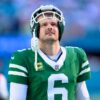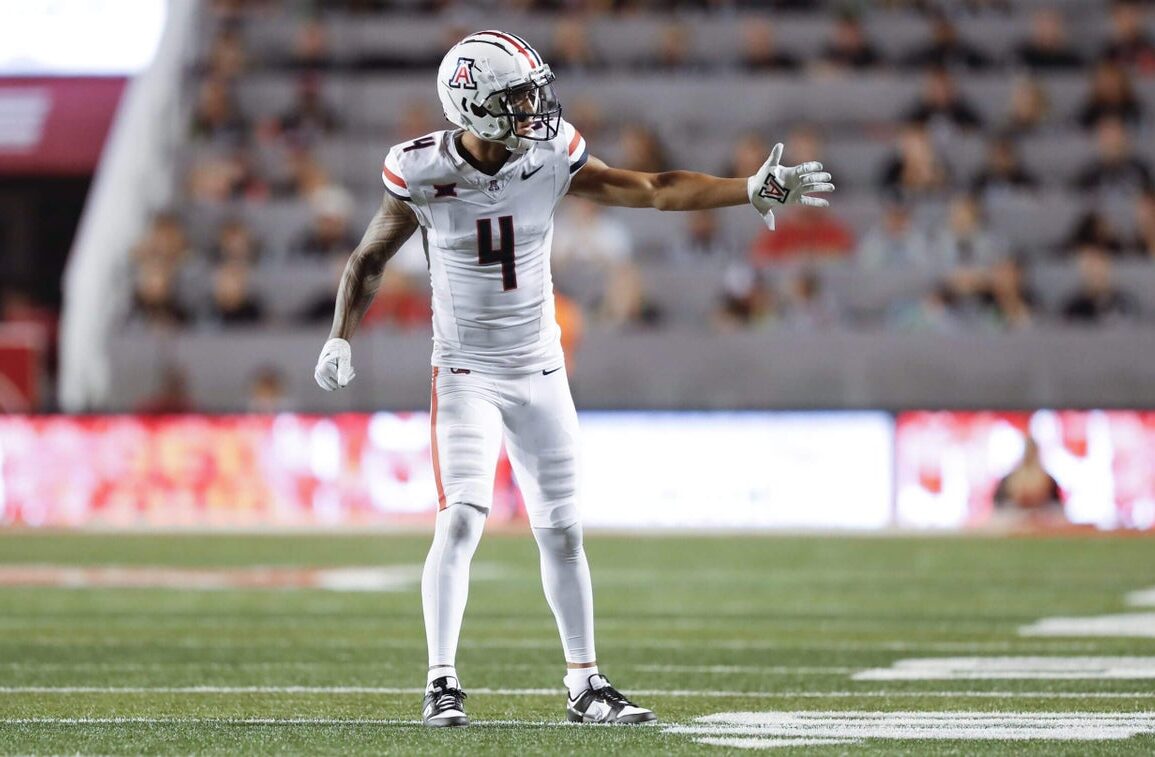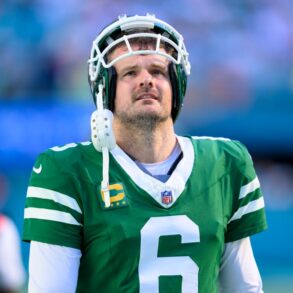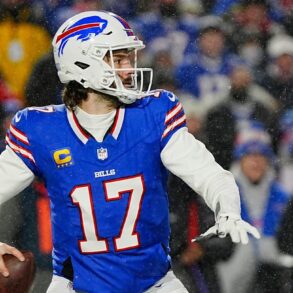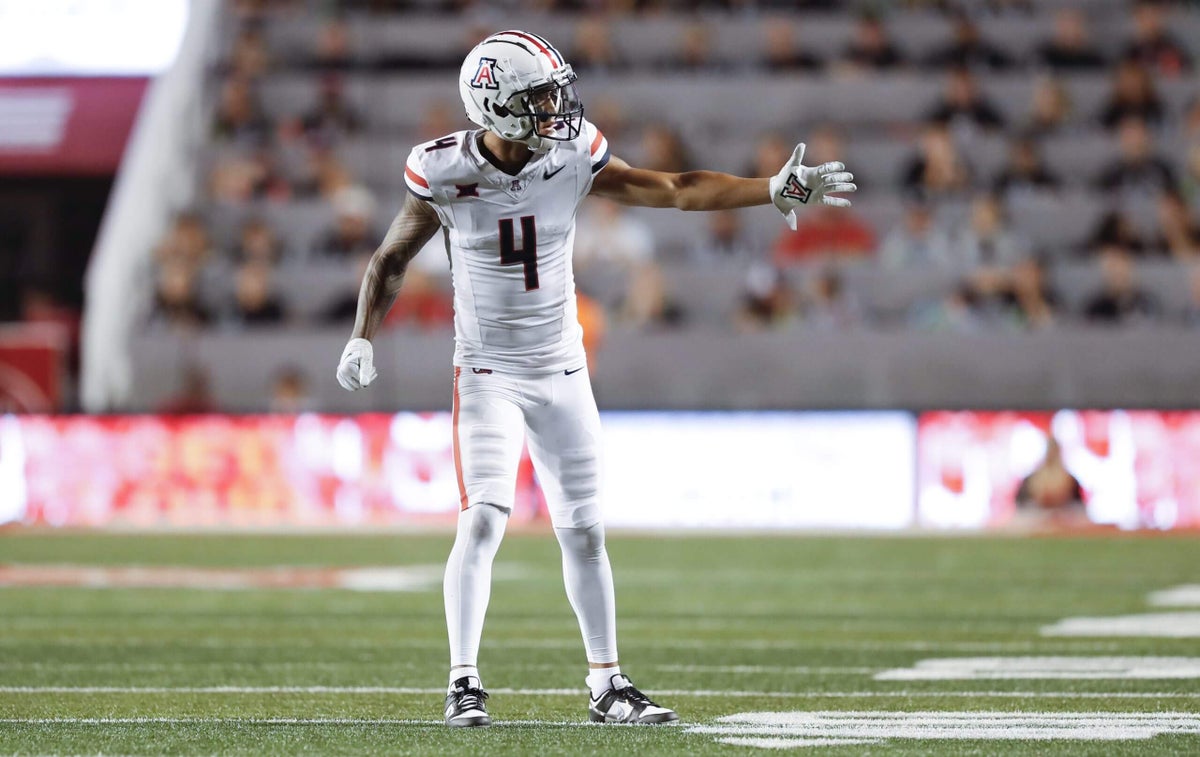
The 2025 NFL Draft is drawing near. Rookies will soon have an official home, but they have unofficial landing spots courtesy of all the industry mock drafts. The NFL Mock Draft Database puts together a consensus mock draft, assigning players to the team that a plurality of mock drafts predict will be their landing spot.
Advertisement
Rookie performance is like real estate — location, location, location. Unlike in baseball, where it doesn’t matter where a player hits or pitches because he will hit and pitch the same way regardless, in football, a player’s supporting cast, coaching, usage and play calling determine performance more than his ability.
This is why drafting rookies in dynasty leagues before the actual NFL draft is the ultimate act of hubris. Your scouting vibe of the player doesn’t amount to a hill of beans in this absurd professional world. Is the hot rookie WR going to a team with an alpha in place, or will he start as the No. 1 target? Will the QB prospect in SuperFlex have a clear path to starting, or is he likely to sit half a year or more? Will the helium tight end actually be on a team that will adjust their offense to feature a tight end, or will he be Kyle Pitts 2.0? Is the first-round running back going to be a bell cow or a committee back, and will he have a QB and receivers who can prevent loaded boxes? (Offensive lines are more of a mystery, year-to-year.)
Here are the top rookie prospects, where they’re expected to be drafted and by whom, along with their current, flying blind, Best Ball ADP in NFFC leagues. I’m listing the players in their expected real-life draft order.
Cam Ward, QB (No. 1 overall, 96% Tennessee Titans)
You can pretty much bet the farm to win a pittance on Ward being the first pick. Can top rookie QB prospects be at least 6-foot-2 anymore? The coaching staff has experience with Joe Burrow and Trevor Lawrence. According to our Dane Brugler’s The Beast draft guide, Ward is more of a “Mahomes-type of scrambler.” So the team and coach matter more than they would with more of a Konami Code running QB. I can’t see the fit in the near term. Neither can the market, with Ward now the 28th QB off the fantasy football draft board.
Advertisement
Travis Hunter, WR/CB (No. 2, 75% Cleveland Browns)
We want the slash to be WR/CB (in that order). But to be fair, it seems more likely for a primary corner to play a little WR than for a primary WR to play a little cornerback. Actually, for fantasy, we don’t even want the slash. We just want Hunter to be a wide receiver. Brugler says he’s “WR1 in this class” (and also CB1). It’s odd that everyone basically has him as a corner — WR is the more expensive position and the one that’s harder to fill in free agency. But that’s why his early ADP is WR59 right now.
Ashton Jeanty, RB (No. 6, 57% Las Vegas Raiders)
Pete Carroll will employ a bell-cow approach when health and ability allow, as he did with Marshawn Lynch. So no worries there. Jeanty doesn’t need a great offensive line. The passing game is powered by a tight end, a position Geno Smith has rarely featured — it’s also never been featured in a Carroll offense. The running back should be the last piece, really. Jeanty is a thrilling talent and shows the ability to be a top pass catcher, but I’m more bearish than the fantasy market, which has him at RB6. Smith-Carroll teams have never featured running backs much as receivers. I would bet Jeanty won’t be the top rookie RB.
Shedeur Sanders, QB (No. 9, 42% New Orleans Saints)
With Derek Carr seemingly headed to injured reserve with a shoulder injury, Sanders is ticketed to the Saints in virtually every recent mock draft. He gives me Drew Brees vibes — shorter, not big-armed, super accurate, tough, smart. I’d love this fit even more if New Orleans still had a Sean Payton-themed infrastructure. But this passing and QB offense is rooted in Dak Prescott and Jalen Hurts. I can put Prescott, Brees and Sanders in the same traits bucket. Sanders should start Week 1 in New Orleans. He’s QB29 in ADP. I’d take him over Ward.
Tetairoa McMillan, WR (No. 12, 38% Dallas Cowboys)
It will be hard for McMillan to get much more than 100 targets on a team with CeeDee Lamb. He seems similar to Mike Evans, but McMillan is just a tick slower. But Brugler says he’s a contested catch guy, whereas Evans just blows by people (even in 2024) on deep routes. McMillan also isn’t as strong as Evans was coming out of college, with Brugler citing strength as a weakness. He’s also said to be more of an out-of-structure player than a route runner. I’m not feeling it here in Dallas. McMillan is going at WR34, between Jaylen Waddle and George Pickens. I’m not remotely interested in McMillan at his current price.
Tyler Warren, TE (No. 9, no consensus)
The “no consensus” listing means there’s no consensus on where he’ll be drafted. That “No. 9” is just where he’s ranked on the mock draft consensus big board. Will his landing spot have a coach or play caller who has demonstrated any affinity for emphasizing the TE position? You’d think just drafting a tight end high guarantees that, but we’ve been burned so often in the past. Teams have to change their progressions and plays when they have an elite tight end, and the quarterback has to read more inside-out than outside-in, which is against how almost every team designs an offense.
Advertisement
Colston Loveland, TE (No. 14, 35% Indianapolis Colts)
When I think of a productive tight end, I think of a quarterback who plays in structure and makes quick decisions by repeatedly targeting the tight end in the short middle or beating a defender with a quick outside move. But the Colts have two quarterbacks who hold the ball forever and are not quick processors. So I hate this putative landing spot. Oddly, Loveland is said to be very athletic and WR-like, but I can’t find that he’s run a 40, even at his pro day. I see a 4.70 time in 2022. Al Davis would spin in his grave knowing a team drafted a TE this high without a 40 time. Warren has an ADP of TE10, and Loveland’s is TE20.
Omarion Hampton, RB (No. 20, 44% Denver Broncos)
I think we can all get down with this without even looking at how the experts view him as a talent. This is the perfect landing spot! If it materializes, he will outperform Jeanty and, with an ADP of RB19 (fifth round in Best Ball), at a much cheaper cost. He’s taller and not much heavier than Jeanty. Brugler notes Hampton had 25+ touches in 66% of his games in 2024. Hampton is also lauded for receiving, which has traditionally returned massive dividends in a Payton offense.
Matthew Golden, WR (No. 20, no consensus)
Again, no consensus landing spot. Golden wasn’t very productive in college, especially adjusting for the modern collegiate passing game. Also, he had good college quarterbacks in Texas. Brugler notes that he came on late (102.8 receiving yards over his final four games — SEC championship and three playoff games). He is under 200 pounds; historically, some teams hate that. But Brugler’s scouting report suggests some Tyreek Hill vibes. Fantasy football should root for Green Bay because if the Packers are spending a first-round pick on Golden, it’s an indication they don’t view anyone on their current roster as a No. 1 WR. Golden is WR55 in fantasy drafts right now, and I’d be a buyer if Green Bay materializes since he’d have a chance at top market share.
Jaxson Dart, QB (No. 21, 19% Pittsburgh Steelers)
Dart led the nation in yards per attempt in the SEC, so I don’t get why he’s not viewed as a potential franchise QB and a consensus top-10 pick. Brugler says, “he’s a natural thrower with promising mobility and high-level competitive intangibles.” Okay, sold. Why are we overthinking this? Dart is also unlike the other QB prospects ahead of him in that he’s a shade over 6-foot-2. It’s only an inch, I know, but inches matter. Many passes are deflected by an inch. Dart is QB35 but will go up to QB30 if Pittsburgh drafts him and the Steelers bypass Aaron Rodgers.
Mason Taylor, TE (No. 32, 7% Philadelphia Eagles)
Later first-round prospects have a lower landing-spot probability given the variance in where they’ll be drafted. So 7% is high for pick 32. Taylor’s compared to Hunter Henry by Brugler. The known 40 time on Taylor is actually 0.02 faster than Loveland. If you squint, you’d think this is a good landing spot, given the Eagles seem to want to trade Dallas Goedert. But the issue is that this Philly passing offense is too low-volume. He’s now TE55, undrafted in most leagues.
(Top photo of Tetaiora McMillan: Chris Gardner / Getty Images)
This post was originally published on this site be sure to check out more of their content.


